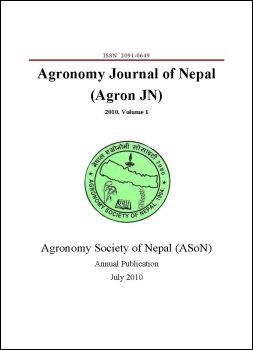Separating climate resilient crops through screening of drought tolerant rice land races in Nepal
DOI:
https://doi.org/10.3126/ajn.v1i0.7546Keywords:
Land races, drought tolerant efficiency (DTE), drought tolerant index (DTI)Abstract
Many studies have shown that local landraces are found to be better adapted to changing climatic conditions. The screening of local land races is one of important processes to detect drought tolerant behavior of crop species to further verify in similar field situation and genomic/molecular level studies. In 2009 for main season rice, a study was done to identify different land races of rice in Jhapa and Kailali districts to know their performance on drought stressed conditions by field techniques. Among the 22 rice land races studied, Kataush showed maximum drought tolerant efficiency (DTE) of 192.8% and minimum drought susceptibility index (DSI) of -0.88% followed by Guthanisaro (DTE=181% and DSI= -0.77%). Likewise, in the cluster analysis, these genotypes formed a cluster with two highest DTE and minimum DSI. Hence, these two land races could be used for drought stressed breeding program in the future to include drought resistant genes for variety impovement. Also, it was recorded that these land races could be used as the most drought tolerant variety in Terai region similar to Jhapa and Kailali, Nepal. These varieties could play important role in climate extreme situations, where farmers can adopt them as climatic resilient rice genotypes.
DOI: http://dx.doi.org/10.3126/ajn.v1i0.7546
Agronomy Journal of Nepal (Agron JN) Vol. 1: 2010 pp.80-84
Downloads
Downloads
Published
How to Cite
Issue
Section
License
ASON permits for free use, distribution and reproduction in any medium if the original work is properly cited and not used for commercial purposes.




